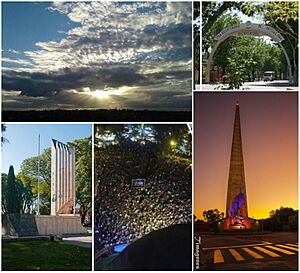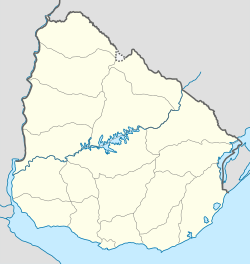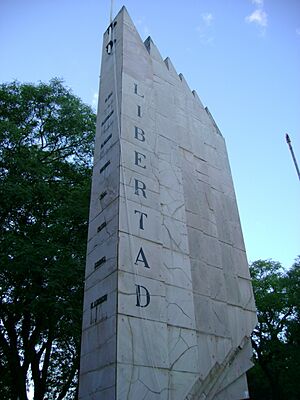Treinta y Tres facts for kids
Quick facts for kids
Treinta y Tres
|
||
|---|---|---|
|
Capital city
|
||
 |
||
|
||
| Country | ||
| Department | ||
| Founded | 10 March 1853 | |
| Elevation | 63 m (207 ft) | |
| Population
(2011 Census)
|
||
| • Total | 25,477 | |
| • Demonym | Treintaitresino | |
| Time zone | UTC -3 | |
| Postal code |
33000
|
|
| Dial plan | +598 445 (+5 digits) | |
| Climate | Cfa | |
Treinta y Tres (which means "Thirty-Three" in Spanish) is an important city in eastern Uruguay. It is the capital city of the Treinta y Tres Department. This city is well-known for its folk music and cultural traditions.
Contents
History of Treinta y Tres
The city's name, "Treinta y Tres," honors a group of national heroes. These heroes were called the 33 Orientals. They played a key role in making Uruguay an independent country in 1825. It's also interesting that the city is located close to the 33°S line of latitude. This makes the name even more fitting!
How the City Grew Over Time
Treinta y Tres officially became a "Pueblo" (which means village) on March 10, 1853. This was made official by a special law. Later, on September 20, 1884, it was chosen as the capital of its department. The city continued to grow. On July 19, 1909, it was given the status of "Villa" (a larger town). Finally, on September 29, 1915, it became a "Ciudad" (a city).
Early Education and Travel
Education started early in Treinta y Tres. The first school for boys opened in 1859. Just three years later, in 1862, a school for girls also began operating. This shows how important learning was to the community.
Travel to and from the city also improved over time. In 1861, the first stagecoach service connected Treinta y Tres with Montevideo, the capital of Uruguay. By 1866, this service became regular. It also linked the city to other towns like Río Branco, Melo, and Nico Pérez. Later, in 1912, the city was connected by railroad, making travel even easier.
Population in Treinta y Tres
In 2011, the city of Treinta y Tres had a population of 25,477 people. It is the largest town in its department. The Treinta y Tres Department is not very crowded. When you include the nearby areas like Ejido de Treinta y Tres and Villa Sara, the total population center is about 33,000 people.
| Historical population | ||||||||||||||||||||||||||||
|---|---|---|---|---|---|---|---|---|---|---|---|---|---|---|---|---|---|---|---|---|---|---|---|---|---|---|---|---|
|
|
|||||||||||||||||||||||||||
| Source: Instituto Nacional de Estadística de Uruguay | ||||||||||||||||||||||||||||
Economy of Treinta y Tres
The main part of Treinta y Tres's economy comes from raising animals. This includes cattle and other livestock. Products like meat and dairy come from these animals.
Key Industries and Crops
Today, rice is the most important crop grown in the area. It grows very well near the city's many rivers. Rice farming has greatly helped the region's economy. It has led to new businesses that make pre-cooked rice products. Many rice mills have also been built. In recent years, the production of cement and limestone has also become very important.
Geography of Treinta y Tres
The city of Treinta y Tres is located on Route 8. It sits on the northern banks of the Olimar Grande River. A rural area with many small farms, known as chacras, surrounds the city. This area is called Ejido de Treinta y Tres.
Climate in Treinta y Tres
The climate in Treinta y Tres has hot and humid summers. The winters are usually mild to cool. This type of weather is known as a humid subtropical climate. On climate maps, it is often shown as "Cfa."
| Climate data for Treinta y Tres (1991–2020, extremes 1939–2020) | |||||||||||||
|---|---|---|---|---|---|---|---|---|---|---|---|---|---|
| Month | Jan | Feb | Mar | Apr | May | Jun | Jul | Aug | Sep | Oct | Nov | Dec | Year |
| Record high °C (°F) | 41.1 (106.0) |
40.5 (104.9) |
40.2 (104.4) |
36.4 (97.5) |
31.2 (88.2) |
29.0 (84.2) |
31.2 (88.2) |
34.7 (94.5) |
35.0 (95.0) |
34.8 (94.6) |
39.7 (103.5) |
41.5 (106.7) |
41.5 (106.7) |
| Mean daily maximum °C (°F) | 30.0 (86.0) |
29.0 (84.2) |
27.5 (81.5) |
23.9 (75.0) |
20.1 (68.2) |
17.1 (62.8) |
16.5 (61.7) |
18.4 (65.1) |
19.8 (67.6) |
22.8 (73.0) |
25.8 (78.4) |
28.5 (83.3) |
23.3 (73.9) |
| Daily mean °C (°F) | 23.9 (75.0) |
23.3 (73.9) |
21.7 (71.1) |
18.4 (65.1) |
14.9 (58.8) |
12.2 (54.0) |
11.6 (52.9) |
13.2 (55.8) |
14.6 (58.3) |
17.5 (63.5) |
19.9 (67.8) |
22.2 (72.0) |
17.8 (64.0) |
| Mean daily minimum °C (°F) | 17.8 (64.0) |
17.6 (63.7) |
16.0 (60.8) |
13.0 (55.4) |
9.8 (49.6) |
7.4 (45.3) |
6.7 (44.1) |
8.0 (46.4) |
9.4 (48.9) |
12.1 (53.8) |
14.0 (57.2) |
16.1 (61.0) |
12.3 (54.1) |
| Record low °C (°F) | 1.8 (35.2) |
4.5 (40.1) |
2.0 (35.6) |
−1.2 (29.8) |
−2.8 (27.0) |
−7.6 (18.3) |
−4.6 (23.7) |
−4.0 (24.8) |
−4.2 (24.4) |
−1.2 (29.8) |
1.4 (34.5) |
1.0 (33.8) |
−7.6 (18.3) |
| Average precipitation mm (inches) | 110.1 (4.33) |
121.2 (4.77) |
107.7 (4.24) |
137.8 (5.43) |
136.6 (5.38) |
125.5 (4.94) |
107.7 (4.24) |
118.7 (4.67) |
118.8 (4.68) |
120.8 (4.76) |
82.5 (3.25) |
122.6 (4.83) |
1,410 (55.52) |
| Average precipitation days (≥ 1.0 mm) | 7 | 7 | 7 | 7 | 7 | 8 | 7 | 7 | 7 | 8 | 6 | 8 | 86 |
| Average relative humidity (%) | 70 | 74 | 76 | 79 | 81 | 83 | 81 | 79 | 77 | 75 | 72 | 70 | 76 |
| Mean monthly sunshine hours | 266.6 | 214.7 | 220.1 | 183.0 | 170.5 | 132.0 | 145.7 | 164.3 | 174.0 | 210.8 | 240.0 | 263.5 | 2,385.2 |
| Mean daily sunshine hours | 8.6 | 7.6 | 7.1 | 6.1 | 5.5 | 4.4 | 4.7 | 5.3 | 5.8 | 6.8 | 8.0 | 8.5 | 6.5 |
| Source 1: Instituto Uruguayo de Metereología | |||||||||||||
| Source 2: NOAA (precipitation and sun 1991–2020), Instituto Nacional de Investigación Agropecuaria (humidity and sun 1980–2009) | |||||||||||||
Places of Worship
- St. Joseph the Worker Parish Church (Roman Catholic)
- Parish Church of Our Lady of the Thirty-Three (Roman Catholic)
- Parish Church of the Holy Savior (Roman Catholic)
Notable People from Treinta y Tres
- Emiliano Alfaro - a professional footballer
- Gonzalo Lemes - a professional footballer
- Darío Silva - a professional footballer
- Octavio Rivero - a professional footballer
See also
 In Spanish: Treinta y Tres (Uruguay) para niños
In Spanish: Treinta y Tres (Uruguay) para niños




